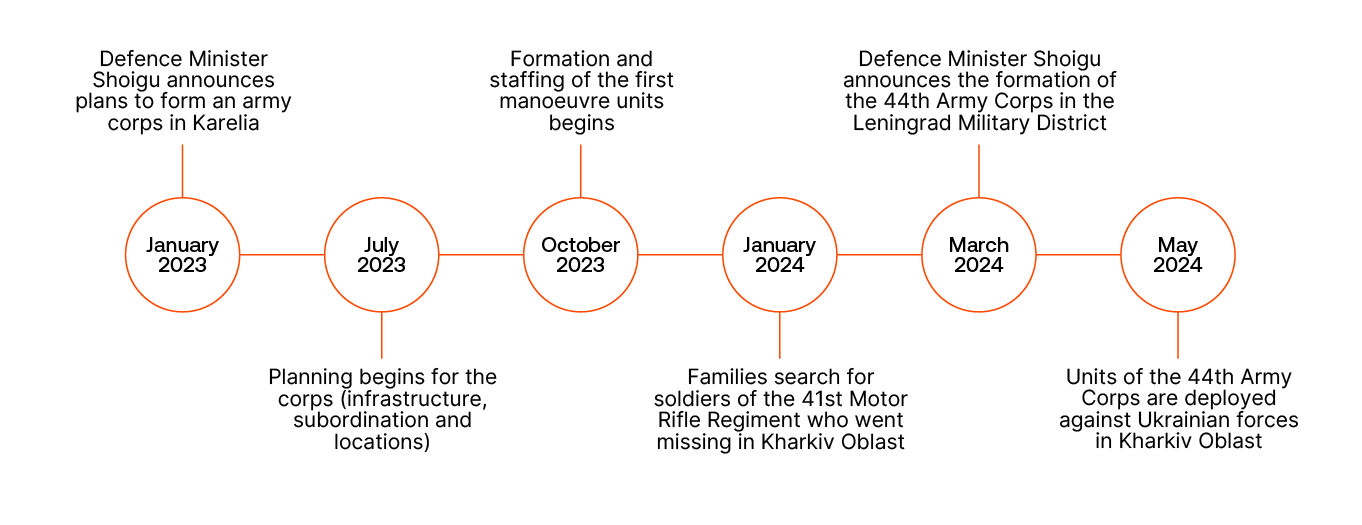1.1
Russia’s armed forces are expanding: The example of the 44th Army Corps
Share:
20.12.2024
Eesti keelesRussia continues to mobilise resources and rebuild a mass army to sustain its war in Ukraine and prepare for a potential conflict with NATO. The pace of this rearmament depends on the duration and outcome of the war.
By 2025, Russia is expected to form additional divisions and combat support and service support units in the Leningrad and Moscow military districts.
Should the war in Ukraine end favourably for Russia or if hostilities are frozen, it is almost certain that Russian military units will be permanently stationed along Estonia’s borders in more significant numbers than before 24 February 2022.
The formation of units under the 44th Army Corps shows that, despite combat losses, Russia has sufficient resources to not only recover but also expand and modernise its armed forces.
Despite suffering the largest post-World War II human losses on the battlefield, Russia’s armed forces are growing. New units and formations are being established, primarily with recruited contract soldiers. Russia is not merely restoring its pre-war personnel numbers of 600,000-700,000 soldiers; this target was already reached during the partial mobilisation in autumn 2022. Since then, Russia has simultaneously worked to restore the combat readiness of its operational forces and implement force generation by creating new units staffed with contracted personnel. By 2026, the Kremlin aims to expand its military to 1.5 million soldiers.
In 2024, the Russian Armed Forces re-established the Leningrad Military District, forming the 44th Army Corps and the 6th Combined Arms Army’s 69th Motor Rifle Division (Kamenka, formerly the 138th Guards Separate Motor Rifle Brigade) near Estonia. After their formation, both units were deployed to the Ukrainian front to gain combat experience. Additionally, in the second half of 2024, the 6th Combined Arms Army began forming the 68th Motorised Rifle Division (Luga, formerly the 25th Guards Separate Motor Rifle Brigade), with this process likely to continue into 2025. The fact that both an army corps and a motorised rifle division were assembled near Estonia within a single year demonstrates Russia’s capacity to create large military formations in a relatively short time.
The 44th Army Corps, which contributed to the increase in Russian forces near Estonia in 2024, is planned for permanent deployment in the direction of Finland. Its core units were established over seven or eight months between autumn 2023 and spring 2024, primarily using newly recruited contract soldiers. The manoeuvre units of this corps – the 72nd Motor Rifle Division and the 128th Motor Rifle Brigade – saw their first combat in May 2024 in Kharkiv Oblast, where they attacked Ukrainian forces. Their training period, in line with Russia’s current warfare practices, was brief and concentrated on individual skills and small-unit tactics (squad, platoon, company).
OLD MILITARY GARRISONS REPURPOSED
Old military garrisons in the Republic of Karelia will be repurposed to house new units.
The formation of the 44th Army Corps’ combat support and service support units is expected to continue into 2025, as their training, arming and equipping require more time. The permanent bases for these units will likely include repurposed old garrisons in the Republic of Karelia. Renovating and constructing these facilities is projected to take at least three to four years, while the necessary housing for military personnel and their families will likely require even more time.
In summary, Russia is expanding its armed forces both on paper – through presidential decrees increasing the official number of military positions – and, in practice, through recruitment. The establishment of units under the 6th Combined Arms Army and the 44th Army Corps in 2024 confirms that the Kremlin is not merely making plans but is also successfully executing the creation of new units. Over the next two years, a lack of political will is unlikely to impede the mobilisation of additional resources. However, the sustainability of forming and maintaining new formations over a three-to-five-year horizon remains uncertain, depending heavily on the duration of the Russia-Ukraine war, Russia’s economic resilience and the determination of Western nations to maintain sanctions.

Russian soldiers during a parade on Moscow’s Red Square in May 2024
Source: Evgenia Novozhenina/Reuters
The Kremlin has chosen a path of long-term confrontation, committing to the mobilisation of additional societal resources to rebuild the military and achieve its reform goals. If Russia succeeds in continuing its military reform and forming the planned units, Estonia and NATO will face a Russian force posture in the coming years that poses a sustained military threat.

Formation of the 44th Army Corps (2023-2024)
Share:
20.12.2024
Eesti keeles